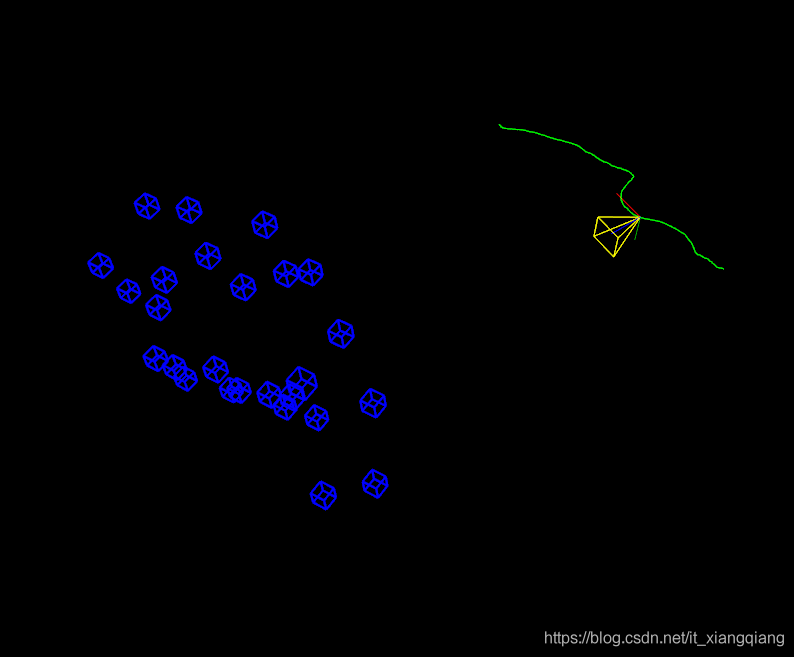相机运动估计
目标
在本教程中,您将学习如何使用重建API进行摄像机运动估计:
加载具有跟踪的2d点的文件,并在所有框架上构建容器。
运行libmv重建管道。
使用Viz显示获得的结果。
代码
#include<opencv2/core.hpp>#include<opencv2/sfm.hpp>#include<opencv2/viz.hpp>#include<iostream>#include<fstream>usingnamespace std;usingnamespace cv;usingnamespace cv::sfm;staticvoidhelp(){
cout
<<"\n------------------------------------------------------------------\n"<<" This program shows the camera trajectory reconstruction capabilities\n"<<" in the OpenCV Structure From Motion (SFM) module.\n"<<" \n"<<" Usage:\n"<<" example_sfm_trajectory_reconstruction <path_to_tracks_file> <f> <cx> <cy>\n"<<" where: is the tracks file absolute path into your system. \n"<<" \n"<<" The file must have the following format: \n"<<" row1 : x1 y1 x2 y2 ... x36 y36 for track 1\n"<<" row2 : x1 y1 x2 y2 ... x36 y36 for track 2\n"<<" etc\n"<<" \n"<<" i.e. a row gives the 2D measured position of a point as it is tracked\n"<<" through frames 1 to 36. If there is no match found in a view then x\n"<<" and y are -1.\n"<<" \n"<<" Each row corresponds to a different point.\n"<<" \n"<<" f is the focal length in pixels. \n"<<" cx is the image principal point x coordinates in pixels. \n"<<" cy is the image principal point y coordinates in pixels. \n"<<"------------------------------------------------------------------\n\n"<< endl;}/* Build the following structure data
*
* frame1 frame2 frameN
* track1 | (x11,y11) | -> | (x12,y12) | -> | (x1N,y1N) |
* track2 | (x21,y11) | -> | (x22,y22) | -> | (x2N,y2N) |
* trackN | (xN1,yN1) | -> | (xN2,yN2) | -> | (xNN,yNN) |
*
*
* In case a marker (x,y) does not appear in a frame its
* values will be (-1,-1).
*/staticvoidparser_2D_tracks(const String &_filename, std::vector<Mat>&points2d ){
ifstream myfile(_filename.c_str());if(!myfile.is_open()){
cout <<"Unable to read file: "<< _filename << endl;exit(0);}else{
double x, y;
string line_str;int n_frames =0, n_tracks =0;// extract data from text file
vector<vector<Vec2d>> tracks;for(;getline(myfile,line_str);++n_tracks){
istringstream line(line_str);
vector<Vec2d> track;for( n_frames =0; line >> x >> y;++n_frames){
if( x >0&& y >0)
track.push_back(Vec2d(x,y));else
track.push_back(Vec2d(-1));}
tracks.push_back(track);}// embed data in reconstruction api formatfor(int i =0; i < n_frames;++i){
Mat_<double>frame(2, n_tracks);for(int j =0; j < n_tracks;++j){
frame(0,j)= tracks[j][i][0];frame(1,j)= tracks[j][i][1];}
points2d.push_back(Mat(frame));}
myfile.close();}}/* Keyboard callback to control 3D visualization
*/bool camera_pov =false;staticvoidkeyboard_callback(const viz::KeyboardEvent &event,void* cookie){
if( event.action ==0&&!event.symbol.compare("s"))
camera_pov =!camera_pov;}/* Sample main code
*/intmain(int argc,char** argv){
// Read input parametersif( argc !=5){
help();exit(0);}// Read 2D points from text file
std::vector<Mat> points2d;parser_2D_tracks( argv[1], points2d );// Set the camera calibration matrixconstdouble f =atof(argv[2]),
cx =atof(argv[3]), cy =atof(argv[4]);
Matx33d K =Matx33d( f,0, cx,0, f, cy,0,0,1);bool is_projective =true;
vector<Mat> Rs_est, ts_est, points3d_estimated;reconstruct(points2d, Rs_est, ts_est, K, points3d_estimated, is_projective);// Print output
cout <<"\n----------------------------\n"<< endl;
cout <<"Reconstruction: "<< endl;
cout <<"============================"<< endl;
cout <<"Estimated 3D points: "<< points3d_estimated.size()<< endl;
cout <<"Estimated cameras: "<< Rs_est.size()<< endl;
cout <<"Refined intrinsics: "<< endl << K << endl << endl;
cout <<"3D Visualization: "<< endl;
cout <<"============================"<< endl;
viz::Viz3d window_est("Estimation Coordinate Frame");
window_est.setBackgroundColor();// black by default
window_est.registerKeyboardCallback(&keyboard_callback);// Create the pointcloud
cout <<"Recovering points ... ";// recover estimated points3d
vector<Vec3f> point_cloud_est;for(int i =0; i < points3d_estimated.size();++i)
point_cloud_est.push_back(Vec3f(points3d_estimated[i]));
cout <<"[DONE]"<< endl;
cout <<"Recovering cameras ... ";
vector<Affine3d> path_est;for(size_t i =0; i < Rs_est.size();++i)
path_est.push_back(Affine3d(Rs_est[i],ts_est[i]));
cout <<"[DONE]"<< endl;
cout <<"Rendering Trajectory ... ";
cout << endl <<"Press: "<< endl;
cout <<" 's' to switch the camera pov"<< endl;
cout <<" 'q' to close the windows "<< endl;if( path_est.size()>0){
// animated trajectoryint idx =0, forw =-1, n =static_cast<int>(path_est.size());while(!window_est.wasStopped()){
for(size_t i =0; i < point_cloud_est.size();++i){
Vec3d point = point_cloud_est[i];
Affine3d point_pose(Mat::eye(3,3,CV_64F), point);char buffer[50];
sprintf (buffer,"%d",static_cast<int>(i));
viz::WCube cube_widget(Point3f(0.1,0.1,0.0),Point3f(0.0,0.0,-0.1),true, viz::Color::blue());
cube_widget.setRenderingProperty(viz::LINE_WIDTH,2.0);
window_est.showWidget("Cube"+String(buffer), cube_widget, point_pose);}
Affine3d cam_pose = path_est[idx];
viz::WCameraPosition cpw(0.25);// Coordinate axes
viz::WCameraPosition cpw_frustum(K,0.3, viz::Color::yellow());// Camera frustumif( camera_pov )
window_est.setViewerPose(cam_pose);else{
// render complete trajectory
window_est.showWidget("cameras_frames_and_lines_est", viz::WTrajectory(path_est, viz::WTrajectory::PATH,1.0, viz::Color::green()));
window_est.showWidget("CPW", cpw, cam_pose);
window_est.showWidget("CPW_FRUSTUM", cpw_frustum, cam_pose);}// update trajectory index (spring effect)
forw *=(idx==n || idx==0)?-1:1; idx += forw;// frame rate 1s
window_est.spinOnce(1,true);
window_est.removeAllWidgets();}}return0;}解释
首先,我们需要加载包含在所有帧上跟踪的2d点的文件,并构造容器以提供重建api。在这种情况下,跟踪的2d点将具有以下结构,即2d点数组的矢量,其中每个内部数组代表一个不同的帧。每个帧由2d个点的列表组成,例如,帧1中的第一个点与帧2中的相同点。如果帧中没有点,则分配的值将为(-1,-1):
for(int i =0; i < n_frames;++i){
Mat_<double>frame(2, n_tracks);for(int j =0; j < n_tracks;++j){
frame(0,j)= tracks[j][i][0];frame(1,j)= tracks[j][i][1];}
points2d.push_back(Mat(frame));}其次,构建的容器将用于提供重建API。重要的一点是,估计结果必须存储在vector 中:
bool is_projective =true;
vector<Mat> Rs_est, ts_est, points3d_estimated;reconstruct(points2d, Rs_est, ts_est, K, points3d_estimated, is_projective);// Print output
cout <<"\n----------------------------\n"<< endl;
cout <<"Reconstruction: "<< endl;
cout <<"============================"<< endl;
cout <<"Estimated 3D points: "<< points3d_estimated.size()<< endl;
cout <<"Estimated cameras: "<< Rs_est.size()<< endl;
cout <<"Refined intrinsics: "<< endl << K << endl << endl;最后,所获得的结果将显示在Viz中,在这种情况下,相机将产生振荡效果。
用法和结果
为了运行此示例,我们需要指定跟踪点文件的路径,相机的焦距以及中心投影坐标(以像素为单位)。您可以在samples / data / desktop_trakcks.txt中找到示例文件
./example_sfm_trajectory_reconstruction desktop_tracks.txt 1914640360下图显示了从跟踪的2d点获得的摄像机运动:









 该教程展示了如何利用OpenCV的StructureFromMotion(SFM)模块进行相机运动估计。通过读取带有跟踪2d点的文件,构建容器,然后运行libmv重建管道,最终使用Viz进行3D结果的可视化展示。用户需提供跟踪文件路径、焦距和主点坐标作为输入参数。
该教程展示了如何利用OpenCV的StructureFromMotion(SFM)模块进行相机运动估计。通过读取带有跟踪2d点的文件,构建容器,然后运行libmv重建管道,最终使用Viz进行3D结果的可视化展示。用户需提供跟踪文件路径、焦距和主点坐标作为输入参数。

















 232
232

 被折叠的 条评论
为什么被折叠?
被折叠的 条评论
为什么被折叠?








